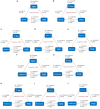Potential value of serum prealbumin and serum albumin in the identification of postoperative delirium in patients undergoing knee/hip replacement: an observational study and internal validation study
- PMID: 38694772
- PMCID: PMC11061387
- DOI: 10.3389/fneur.2024.1375383
Potential value of serum prealbumin and serum albumin in the identification of postoperative delirium in patients undergoing knee/hip replacement: an observational study and internal validation study
Abstract
Background: Postoperative delirium (POD) is a common postoperative neurological complication that can lead to a variety of postoperative complications. At present, the pathogenesis of POD is unclear. This study aims to explore the relationship between serum prealbumin and serum albumin and POD and whether serum prealbumin and serum albumin influence POD through POD core pathology.
Objective: We enrolled 500 Chinese Han patients between September 2020 to January 2023. We analyzed the risk and protective factors of POD using the multivariate logistic regression. We also assessed the predictive power of serum prealbumin, serum albumin, and both in combination with CSF POD biomarkers. We used Stata MP16.0. to examine whether the association between serum prealbumin and serum albumin and POD was mediated by CSF POD biomarkers, and conducted an internal validation study to verify the accuracy of the combination of serum prealbumin + serum albumin + CSF POD biomarkers for predicting POD. The model was visualized using ROC curve and decision curve analysis (DCA). DynNom and Shiny packages were used to create an online calculator. Ten patients who had POD occurring from February 2023 to October 2023 were selected for internal verification.
Results: Finally, a total of 364 patients were included in our study. Levels of serum prealbumin, serum albumin in the POD group were lower than those in the NPOD group. The lever of serum prealbumin, serum albumin were protective factors for POD. The relationship between serum prealbumin, serum albumin and POD was partially mediated by T-tau (12.28%) and P-tau (20.61%). The model combining serum prealbumin and serum albumin and POD biomarkers exhibited a relatively better discriminatory ability to predict POD. DCA also showed that the combination of serum prealbumin and serum albumin and POD biomarkers brought high predictive benefits to patients. The dynamic online calculator can accurately predict the occurrence of POD in the internal validation study.
Conclusion: Preoperative low serum prealbumin and serum albumin levels were the preoperative risk factors for POD, which is partly mediated by T-tau and P-tau. The model combining serum prealbumin and serum albumin and CSF POD biomarkers can accurately predict the occurrence of POD.
Clinical trial registration: http://www.clinicaltrials.gov, identifier ChiCTR2000033439.
Keywords: biomarkers; neurodegeneration; perioperative neurocognitive disorders; serum albumin; serum prealbumin.
Copyright © 2024 Wang, Xin, Tang, Wang, Hua, Yang, Xu, Gong, Dong, Lin, Li, Lin and Bi.
Conflict of interest statement
The authors declare that the research was conducted in the absence of any commercial or financial relationships that could be construed as a potential conflict of interest.
Figures








Similar articles
-
Potential Value of Cerebrospinal Fluid Progranulin in the Identification of Postoperative Delirium in Geriatrics Patients Undergoing Knee Replacement: The Perioperative Neurocognitive Disorder and Biomarker LifestylE Study.Front Aging Neurosci. 2022 Jan 6;13:772795. doi: 10.3389/fnagi.2021.772795. eCollection 2021. Front Aging Neurosci. 2022. PMID: 35069175 Free PMC article.
-
The Relationship Between Cardiovascular Disease Risk Score and Postoperative Delirium: The PNDABLE Study.Front Aging Neurosci. 2022 Jun 21;14:851372. doi: 10.3389/fnagi.2022.851372. eCollection 2022. Front Aging Neurosci. 2022. PMID: 35800979 Free PMC article.
-
Potential Value of Serum Lipid in the Identication of Postoperative Delirium Undergoing Knee/Hip Arthroplasty: The Perioperative Neurocognitive Disorder and Biomarker Lifestyle Study.Front Psychiatry. 2022 Apr 12;13:870317. doi: 10.3389/fpsyt.2022.870317. eCollection 2022. Front Psychiatry. 2022. PMID: 35492710 Free PMC article.
-
Potential value of preoperative fasting blood glucose levels in the identification of postoperative delirium in non-diabetic older patients undergoing total hip replacement: The perioperative neurocognitive disorder and biomarker lifestyle study.Front Psychiatry. 2022 Oct 13;13:941048. doi: 10.3389/fpsyt.2022.941048. eCollection 2022. Front Psychiatry. 2022. PMID: 36311514 Free PMC article.
-
Review of Postoperative Delirium in Geriatric Patients After Hip Fracture Treatment.Geriatr Orthop Surg Rehabil. 2022 Mar 4;13:21514593211058947. doi: 10.1177/21514593211058947. eCollection 2022. Geriatr Orthop Surg Rehabil. 2022. PMID: 35282299 Free PMC article. Review.
Cited by
-
Clinical biomarkers of perioperative neurocognitive disorder: initiation and recommendation.Sci China Life Sci. 2025 Jul;68(7):1912-1940. doi: 10.1007/s11427-024-2797-x. Epub 2025 Jan 22. Sci China Life Sci. 2025. PMID: 39918707 Review.
-
Preoperative Prognostic Nutritional Index as a Useful Tool for Predicting Postoperative Delirium in Elderly Patients with Degenerative Lumbar Diseases.Ther Clin Risk Manag. 2025 Jun 7;21:851-859. doi: 10.2147/TCRM.S520912. eCollection 2025. Ther Clin Risk Manag. 2025. PMID: 40503213 Free PMC article.
References
LinkOut - more resources
Full Text Sources
Research Materials

